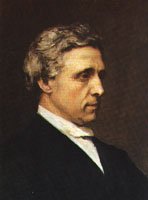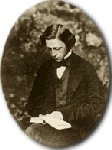About Lewis Carroll
Lewis Carroll is the author of “Alice’s Adventures in Wonderland” and “Through the Looking-Glass and what Alice found there”.
Quick facts
- Pen name: Lewis Carroll
- Real name: Charles Lutwidge Dodgson
- Date of birth: 27 January 1832
- Date of death: 14 January 1898
Pseudonym
 ‘Lewis Carroll’ is an pseudonym; the real name of the author was Charles Lutwidge Dodgson. (His last name is pronounced with a silent ‘g’.)
‘Lewis Carroll’ is an pseudonym; the real name of the author was Charles Lutwidge Dodgson. (His last name is pronounced with a silent ‘g’.)
Dodgson first used ‘B.B.’ to sign his non-professional writings, but in March 1856, when he wanted to publish his poem ‘Solitude’ in the magazine “The Train”, Edmund Yates, a magazine editor, thought that this one was not appropriate. Then Dodgson came up with ‘Dares’ (from Daresbury in Cheshire, his birthplace), but that one was also rejected. Finally he invented Edgar Cuthwellis (composed from the letters of his name), Edgar U.C. Westhill (idem), Louis Carroll (he translated his name to Latin, and back: Lutwidge = Ludovic = Louis, Charles = Carolus) and Lewis Carroll (idem). Yates chose the last one.
For his learned mathematic books Dodgson used his own name. An exception to this is ‘Symbolic Logic Part 1’. It was published under the name of Lewis Carroll, as he intended it to be a less specialized work aimed at different type of audience.
Dodgson rarely publicly acknowledged that he was also Lewis Carroll. He seldom signed his books, and never gave away his portrait. Dodgson did acknowledge his pen name among his friends (especially in the letters to his child-friends which he signed with that name) but publicly denied any connection with the Alice books. He made some exceptions though, especially when he thought the name ‘Lewis Carroll’ would facilitate his reception when meeting new people.
He regularly returned strangers’ mail addressed to him as Lewis Carroll with a printed leaflet that asserted, “Mr. Dodgson is so frequently addressed by strangers on the quite unauthorized assumption that he claims or at any rate acknowledges the authorship of books not published under his name, that he has found it necessary to print this, once and for all, as an answer to all such applications. He neither claims or acknowledges any connection with any pseudonym, or with any book that is not published under his own name.” (Rackin 15)
The life of Dodgson
 Dodgson was born on 27 January 1832 in the old parsonage at Daresbury, Cheshire. He was the 3rd child and eldest son of Reverend Charles Dodgson and Frances Jane Lutwidge (who were first cousins) and had 3 brothers and 7 sisters. He was very close and protective of them, especially the girls. Even as a child his talent was evident as he clearly enjoyed entertaining his brothers and sisters with stories and games.
Dodgson was born on 27 January 1832 in the old parsonage at Daresbury, Cheshire. He was the 3rd child and eldest son of Reverend Charles Dodgson and Frances Jane Lutwidge (who were first cousins) and had 3 brothers and 7 sisters. He was very close and protective of them, especially the girls. Even as a child his talent was evident as he clearly enjoyed entertaining his brothers and sisters with stories and games.
At the time of his birth, his father, Dr. Dodgson, was the vicar of Daresbury, Cheshire (he later was presented with the Crown living of Croft, Yorkshire, and subsequently became Archdeacon of Richmond and one of the Canons of Ripon Cathedral), and was a distinguished scholar whose favorite study was mathematics.
In 1843 they moved to Croft, Yorkshire. At first, Charles was educated by his father. When he was twelve, he was sent to Mr. Tate’s School at Richmond. In 1846 Dodgson was enrolled at a boarding-school in Rugby where he had a miserable time because of his shyness and several illnesses.
In May 1850 he matriculated at Christ Church, Oxford, where he studied mathematics and took up residence as an undergraduate in January 1851. In 1854 Dodgson gained a 1st class degree in mathematics and one year later he was appointed lecturer in mathematics and Sub-Librarian at Christ Church. Dodgson was not a very inspiring teacher; it is said that his mathematical lessons were quite boring. He taught until 1881.
Dodgson was ordained a deacon in the Church of England on December 22, 1861. In 1898 he went to his sisters in Guildford, where he died of pneumonia on 14 January.
View photographs of Charles Dodgson
Religion
It is often said that Dodgson was a sincere Christian, although there is reason to believe that he had religious doubts. He was ordained a deacon in 1861. It was the rule on Christ Church that deacons should enter the priesthood (or else they’d loose their job), but Dodgson never did. It might have been because of his stammer, but we do not know for certain why the Dean let him get away with it. Dodgson never got married.
Physique
Dodgson stuttered and was asymmetric; his blue eyes were not at the same level and one shoulder was higher than the other. His smile was also slightly askew. He was deaf on one ear because of an illness when he was at Rugby School, suffered from insomnia and was very thin because he ate only one meal a day (he was a little obsessed with eating). According to most accounts he was six foot tall.
Personality
Dodgson was a very precise and punctual man who liked order (he made lists of all kinds of things and even kept track of menus in his diary, so that “people would not have the same dishes too frequently.”).
If something was not to his liking, Dodgson was likely to write a letter to the concerning person. He also satirized the academic politics of Oxford in articles, booklets, and leaflets. He felt that by printing his arguments, rather than debating, he could logically arrange his arguments, and his stammer wouldn’t be a hindrance.
It is said that he also was prudish and very shy, and only at ease in the company of little girls, but this is not the case. Besides his child-friends, Dodgson also had many adult friends which he visited often. Some of these, like actrice Ellen Terry, were former child-friends. Their friendship endured, even though they had grown up.
He loved the company of children, whom he told many stories. He was especially fond of little girls, but it is not true that he disliked boys and babies. He had many child friends, although most of the time he did not keep them very long, and wrote them many letters. If he went on a train journey or to the beach, he always made sure that he had plenty of games and puzzles with him in case he met a new little girl. Alice Liddell was one of his favorite child-friends.
Hobbies and other pastimes
Dodgson was much more than only a mathematician or clergyman; he was a photographer, writer of books and many letters, pamphleteer, poet and inventor. He also was curator of the senior common room at Christ Church (from 1882 to 1892). He was fond of theatre and opera (although his church disapproved of it). He couldn’t endure it if people made jokes about God.
Dodgson was devoted to games as croquet, backgammon, billiards and chess, enjoyed conjuring and card tricks and invented many mathematical and word puzzles, games, ciphers and aids to memory. He was very interested in new inventions and invented many things himself, for example a tool for writing in the dark.
Dodgson read and possessed lots of books. He had a diary that consisted of 13 volumes. If he had a particularly lucky day he wrote ‘I mark this day with a white stone’.
He also liked writing letters, especially humorous letters to his child-friends. From January 1861 until his death in 1898 he kept a register of all the letters that he wrote. It consisted of 24 volumes and contains 98,721 letters!
Dodgson was very interested in photography; he took it up when it was still in its infancy (1856) and was one of the best amateur photographers of his time. He ceased photographing in 1880 for unknown reasons. It is said that he didn’t like the new process of developing the photo’s but that is not certain. He enjoyed sketching or photographing little girls in the nude, because he thought their naked bodies extremely beautiful, but he only did this with their mothers’ permission and if the children were completely at ease with it. He made sure that after his death the pictures would be burned or returned to the mothers. It should be noted that all Victorian artists did studies of child-nudes, which was a trendy subject for the time.
Other writings
In his life Dodsgon wrote many mathematical books, but also books for children. He even wrote mathematical books especially for little children! His most important work was ‘Euclid and his modern rivals’ (1879).
Some other work of his hand: ‘A syllabus of plane algebraical geometry’ (1860); ‘Guide to the mathematical student; elementary treatise on determinants’ (1867); ‘Curiosa mathematica’ (1888); ‘Symbolic logic’ (1896). For children he wrote ‘Phantasmagoria and other poems’ (1869); ‘The hunting of the snark’ (1876); ‘Rhyme? and reason?’ (1883); ‘A tangled tale’ (1885); ‘Sylvie and Bruno’ (1889); ‘Sylvie and Bruno concluded’ (1889).
The Alice books made from Dodgson the most quoted author, Shakespeare and the Bible excepted.

Works cited
Rackin, D.. Alice’s Adventures in Wonderland and Through the Looking-Glass. Nonsense, Sense and Meaning. Twayne Publishers, 1991.